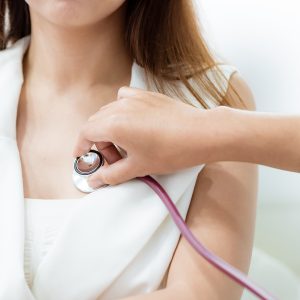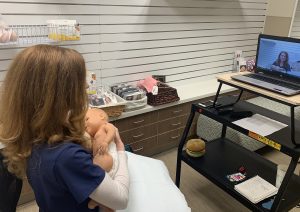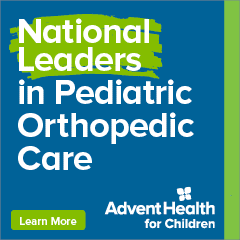Health for Her
Advancements in health care for women show the importance of a whole-body approach.
 Women traditionally put themselves last when it comes to health and wellness, prioritizing appointments for their family members first—whether children or aging parents. Busy schedules are an easy excuse, but the pandemic has placed even more stress on women as statistics show they are shouldering the load of caring for children who have been home more than usual. Any delay in seeing physicians regularly for preventive care could put women at risk of needing more critical care.
Women traditionally put themselves last when it comes to health and wellness, prioritizing appointments for their family members first—whether children or aging parents. Busy schedules are an easy excuse, but the pandemic has placed even more stress on women as statistics show they are shouldering the load of caring for children who have been home more than usual. Any delay in seeing physicians regularly for preventive care could put women at risk of needing more critical care.
The realities of women’s daily lives are not lost on health care professionals in Central Florida. Progress has been made in various fields to provide more comfortable and comprehensive care, including advancements in minimally invasive surgeries, maternal and prenatal health, breast cancer education and even eye and vein health. Orlando Family Magazine spoke with some of the providers who are leading the way in women’s health and the benefits of these new treatments.
Minimally Invasive Gynecologic Surgery
Women commonly need surgeries on their reproductive organs to address uterine fibroids, cysts on the ovaries and endometriosis. A myomectomy can remove fibroids while preserving the uterus, and a hysterectomy removes the uterus and sometimes the cervix, ovaries and Fallopian tubes. In the case of endometriosis, abnormal tissue growth can cause intense pelvic pain and infertility.
Dr. Jessica Vaught, director of minimally invasive surgery at Orlando Health Winnie Palmer Hospital for Women & Babies, says it’s important for women to know that all of these surgeries can be done in a minimally invasive way. “Women are not as educated on their possibilities and providers are not always aware,” she says. “Everyone knows that a gallbladder can be removed with a tiny incision— you wouldn’t accept a surgeon telling you otherwise, so this same standard of care should be given to women.”
These surgeries were traditionally done through a large cut in the abdomen, which is a greater risk for infection, prolongs recovery time in the hospital and could lead to blood clots, pneumonia and over time women could develop a hernia on the incision. “When I came to Orlando in 2007, only 7% of hysterectomies were done minimally invasively—vaginally or with three tiny incisions,” says Boardman. “Now 85% are done this way, using robotic, laparoscopic or vaginal methods.”
Cosmetically, smaller incisions are nicer, but recovery is more important. “Women can go home the same day versus staying in the hospital for several days, and they can return to work in two to three weeks, where the older method for a hysterectomy was four to six weeks,” she says, adding that some cases may still require larger incisions, but women should be sure to press their doctor on which options are most appropriate for them.
“At Winnie Palmer, we are recognized as a Center of Excellence in robotic surgery by the Surgical Review Corporation. This technology is not just a toy for us, we take it seriously and use it responsibly for the best outcomes,” Vaught says.
Vascular Disease Treatment
Dr. Lina Vargas, a board-certified vascular surgeon, runs The Vascular Experts Florida, in Windermere. She says, a broad term to describe a large number of conditions affecting blood vessels, arteries and veins, vascular disease can lead to complications throughout the body.
“Conditions affecting veins are very different and usually involve dysfunction of the valves inside of them that facilitate flow against gravity toward the heart. Other vein conditions include thrombosis or clotting that impair the venous drainage from an extremity leading to pain and swelling, or external compression by other structures or scars affecting venous return as well. Some of these conditions are more common in women, such as venous insufficiency and pelvic congestion syndrome,” Vargas says.
Women commonly present with spider veins or varicose veins on their legs. Spider veins may be purely cosmetic, but varicose veins are related to a condition called venous insufficiency, which affects an estimated 23 million people, she says. “Venous insufficiency usually presents with leg aching, itching, heaviness and tiredness, especially at the end of the day and after prolonged periods of standing or sitting. Leg restlessness has also been associated with venous insufficiency. Most people believe these symptoms are ‘normal’ after working long shifts or walking long distances and that is why they don’t seek for evaluation or treatment.”
If left unchecked, this condition can become more debilitating and irreversible. Vargas says treatment of dysfunctional superficial veins used to involve removal under general anesthesia, which led to significant pain and bruising. “That procedure has been largely replaced by minimally invasive therapies such as laser or chemical ablation of the diseased vein that leads to definitive closure of the vein without removing it. These procedures are currently performed in office-based settings under minimal local anesthetic and with no downtime,” she says. Return to routine activities is encouraged and pain medications are rarely required.
“Women have definitely benefited from these advancements as they now have an option to treat a condition that can be very debilitating both from the physical and aesthetic standpoint without affecting their routines, especially for those who have busy schedules both at work and home as well as those who may be single parents or main-breadwinners,” Vargas says, who adds the access to female physicians and surgeons may make women more likely to seek treatment.
Breast Health
Arguably one of the factors most prominent in women’s minds is their risk for breast cancer. The awareness around the issue is largely due to the work of organizations like the Florida Breast Cancer Foundation (FBCF), which makes education a main component of its mission. That in itself is an advancement, if you ask Tracy Jacim, president and CEO of FBCF.
“Over the years, the awareness of the importance of mammograms and early detection has increased exponentially. The number of lives this has saved is many. When breast cancer, or any cancer for that matter, is detected early, the chance of survival increases greatly. It is the late-stage diagnoses that pose the highest risk for complications,” she says.
In addition to that increased education and awareness, there are advances on the medical and research front. “Most notably, the focus on node preservation and the reduction of lymphedema cases, genomic testing minimizing chemotherapy exposure, oral options for targeted therapy, better identification of hereditary cancer syndromes, new drug combinations making estrogen-blocking agents more effective, and systemic therapies in general,” says Jacim. “We are proud to mention that one of the directors on our board, Dr. Annette Khaled, is working on a way to stop the metastasis of cancer cells.”
This amounts to hope for the future, and Jacim encourages women to reach out. “Knowledge really is power,” she concludes.
 Prenatal and Maternal Virtual Education
Prenatal and Maternal Virtual Education
Having a baby is one of the most exciting moments in a woman’s life, but it also comes with a great deal of questions. While the pandemic changed how places like AdventHealth for Women delivered information, it didn’t slow down.
Cameron Munoz, birth experience and parent education coordinator, says, “At AdventHealth for Women we know that access to prenatal education can play an important role in healthy pregnancies. By transitioning our resources to the virtual setting this year we have been able to continue to provide important education for women.”
Hospital tours help expectant parents familiarize themselves with what will happen during delivery. These continued virtually, as did parent classes at the Baby Place Academy. “We are proud to offer a variety of classes including our childbirth education series, baby care basics, breastfeeding class, Baby Meets Fido class, sibling classes and more,” says Munoz. “We also made our new mom support group, The Baby Bunch, virtual this summer. This free support group is offered twice a week for new mothers and features guest speakers, lactation consultants and a community where new moms can bond and share. We also brought lactation consultations virtual as well.”
This likely will continue to be a staple of AdventHealth’s offerings. “COVID has pushed health care providers to do more telemedicine and virtual visits, and that could be a happy byproduct of what we’ve all been dealing with,” she says. “Even when in-person classes return, we still plan to offer virtual education so women can have access to the information they need. Providing more points of access for women to get the care and advice they need can only lead to better outcomes for them and their babies.”
New Treatments for Incontinence
Incontinence affects twice as many women as men, likely caused by pregnancy, childbirth and menopause. Stress incontinence is the most common type and also more likely affects younger women. This occurs when there is stress or pressure on the bladder due to weak pelvic floor muscles. Coughing, sneezing, laughing, and activities like running can cause leakage.
“It’s no fun if you’ve been a runner all your life and this problem makes you stop doing something you love,” says Dr. Shereen Oloufa, of West Orange Women’s Care. “If you also have the constant urge to go, you’re likely losing sleep, and that affects your overall health.”
Oloufa says laser therapy and platelet-rich plasma (PRP) treatments are showing promising outcomes in initial studies. “These are both non-invasive,” she says. These treatments can help rejuvenate and tighten vaginal tissues, leading to greater bladder support.
“If you document the time and money you’re losing with incontinence— sleep, activity, productivity, the cost of pads— these options can help regain your quality of life,” says Oloufa. “Although they may not be mainstream, it doesn’t mean it’s not something worth investigating to see if you’re a candidate. … I recommend women seek a good physical work up and look at their health goals with their physician.”
Eye Care
Women may not realize it, but they account for approximately two-thirds of all blindness and visual impairment occurrences. “Women are at slightly higher risk than men for developing age-related macular degeneration, glaucoma and ocular side effects from auto-immune conditions. Age-related hormonal changes such as dry eye are also more common in women,” says Dr. Jaya Kumar, retinal specialist at the Florida Retina Institute.
Historically, treatment options were limited, she says. “Now we have several medications that we inject directly in the eye that prevent vision loss and in some cases improve vision. … Intravitreal injections have revolutionized the management of several retinal diseases including wet macular degeneration, diabetic retinopathy, vein occlusion and uveitis.”
Early detection and lifestyle matter to eye health, just like any other medical condition, Dr. Kumar adds. “Women should have an annual eye check up with dilated eye exam, maintain a healthy lifestyle and diet, avoid smoking, wear sunglasses that block both UVA and UVB rays, and wear protective eyewear while working with chemicals or fixing things around the house.”
This article originally appeared in Orlando Family Magazine’s October 2020 issue.









